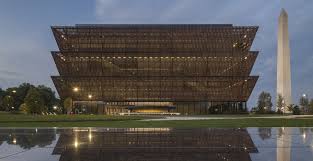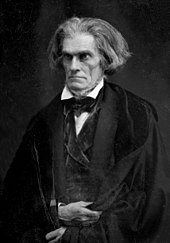
Margie and I are frequent visitors to Washington, DC. We love its history, its cultural activities, and its restaurants. We love the feeling of pride in being Americans that comes with a visit to the city. Over the years we have visited almost every major site from the Tomb of the Unknown Soldier to the Treasury to see money being printed. But there had been one place that had eluded us since it opened in 2016, the National Museum of African American History and Culture. We tend to be last minute travelers and the tickets have always been booked up months in advance, until this year.
We finally got tickets during our visit in May. It was a profound experience and I recommend it to everyone. Beginning with the early 1600s, it is a magnificently presented and emotionally challenging trip through the Black experience in America. As would be expected, slavery plays a significant role in the story told by the museum just as it does in the lives of African Americans and in the history of America.
I can never know nor understand how the history of slavery affects black Americans. I do know, after visiting the museum, I was deeply affected and that if those enslaved people had been my ancestors, I’m not sure I would be able to accept it without deep anger. It made me think that it is time for me to take a deeper look at slavery and how, 150 years later, it still reverberates through our society.

Intellectually, I believe I have had a basic understanding of the facts of slavery, its economics, its structure, and its broader role in history, particularly in the 19th century. But until I saw those exhibits I had not had a true understanding of the suffering, the pain, and the dehumanizing impact inflicted on those who endured it. I want to share with you some of the things I have learned about slavery.
John C. Calhoun, vice president under both John Quincy Adams and Andrew Jackson, was one of the strongest advocates of slavery ever to have served in the US government. He defended slavery as an almost benign institution that benefited the black people who were subjugated in his service. He used the term “the peculiar institution” or “the peculiar labor” to avoid the word slavery. As you can see below, he may also have been one of the scariest looking people ever to have been in our government. But slavery didn’t start in the American south and to begin to understand it we must go further back in history.

Slavery as an institution has been around for millennia. It is even mentioned in the Bible. However, most Americans’ concept of slavery is that of chattel slavery as practiced in the antebellum south in the United States and in the Caribbean. It is important to understand the history of slavery in the world to gain a true perspective on the odious nature of that exceptionally cruel form of slavery.
The practice of slavery preceded written history. It occurred in ancient Egypt, in the early mid-eastern states, and in ancient China. It is described in both the Hebrew and Christian bibles. Mesoamerican civilizations were known to have practiced slavery prior to European contact. It appears to have been well-established in almost all ancient cultures.
However, most historic types of slavery generally differed from what we think of as slavery in the Americas. In ancient civilizations many slaves were either prisoners of war or what were known as debt slaves. War slaves sometimes were repatriated when wars ended. Those who were not sacrificed to the victors’ gods were occasionally integrated into their captor’s society. This is not to say that this type of slavery was not brutal. Slaves were often malnourished and were at times subjected to such arduous working conditions that they died of exhaustion.
Debt slaves were those who entered a period of slavery because of the inability to pay bills but were sometimes able to work their way out of slavery and purchase their freedom. Their treatment, while less harsh than other forms of slavery was far from kindly.
Similarly, the serf system of the European middle ages was a form of slavery where peasants were bound to the land and owed their lords their service but were not specifically owned by the lord. A modern analogy to serfdom occurred in the first decades of the 20th century where miners were bound to the coal companies by their heavy debts to the company store.
Among the earliest international slave traders where the Vikings, who may have been the first to develop the slave trade into a purposeful business rather than a byproduct of war. They raided into the Baltic and Slavic countries and sold their captives into slavery in Western Europe and the northern African Muslim countries. Because Muslim law prohibited one Muslim from holding another in slavery, the trade in slaves quickly became international and highly profitable. It may be apocryphal, but some people claim that the word slave was derived from the fact that many Viking slaves were of Slavic origin.
While it would never be argued that any slaves were well treated, most did not suffer the type of abuse that existed in the Americas. Chattel slavery considered the slave to be not human but property. Property that could be disposed of or treated as the owner saw fit. This led to be a form of abuse which was particularly heinous.
But even this form of slavery was more complex that most of us realize. In the African slave trade, many of the people who were bound into slavery initially were captured and sold by other Africans. Most of the African coast slavers were Black rulers who sold either their subjects or their enemies captured in battle. Many Muslim African rulers had no problem selling other Africans they considered to be pagan. And of course, the Christian whites had no problem enslaving people that they felt to be “less than human.”
While we in the United States focus on slavery in the 13 colonies, most Africans sold into slavery in the Americas were sold in the Caribbean. Slavery on the sugar islands was particularly cruel. Due to disease, over-work and the brutality of the slave owners, most slaves did not survive the first year in the islands. To further underscore how the enslaved were considered as property and not as people, Caribbean slave holders believed to was cheaper to replace those who died than to provide them with adequate food, shelter, or health care.
After the slave importation was abolished in the United States, but while slavery itself was still allowed, many slaves were sold from the 13 colonies into the Caribbean sugar islands. This was little more than a death sentence for those who were shipped there. Families were broken apart with husbands and wives, parents and children never seeing one another again.
Even those who remained on the plantation were often brutally treated. On most plantations, slaves were forced to work from sunrise to sunset six and a half days a week. They had one set of clothes. Often entire families were housed in a 10 by 10 foot cabin and given only meager food. Those who did not work to the satisfaction of the overseer were frequently beaten and women were subjected to sexual abuse without any recourse. Many of the enslaved were not even allowed the basic dignity of a last name, though some, often secretly, gave themselves a last name to express their humanity and to strengthen their family structure.
To understand how these people were treated as property, one only need look at wills and probate records of the time. A will might state the “property includes five horses, a plow, a house, a barn, three black men, two black women, and three black children.” They were listed as property alongside animals and farm tools.
It is little wonder that slaves frequently made any attempt they could to escape to freedom. In fact, it is amazing to me that there were not more slave uprisings.
In the years following the Civil War, as part of the myth of the lost cause, there was an attempt to rewrite history, picturing slavery as being “good” for the slaves. The claim was that it provided them with structure, a Christian education, and a chance to become “civilized.” You can look at photographs taking during and immediately after the Civil War and realize that a big lie was the basis for this claim. People who deny the brutality of slavery have much in common with those who deny the brutality of the Holocaust.
I’m not a believer in original sin or that the evils of past generations are bestowed on the present. However, we must recognize that many of our fellow citizens are still, over 150 years later, strongly influenced by the echoes of the evil of slavery. This has been an open wound for many years. If it is ever to heal, we need to recognize what happened and that many people have a deep emotional tie to that history.
Black Lives Matter has a visceral meaning for African Americans that white Americans can never truly understand. But everyone can understand that there was a time when Black lives didn’t matter.
I don’t have all the answers. I never have and never will. But I do know that healing begins with understanding. Denial only prolongs the hurt. It is time to reach out, from both sides, face the uncomfortable truths and recognize that we are all Americans and must work together for a better country and a brighter future.
And that is my grumpy opinion. Agree or disagree, that is your right, but please give it your thoughtful consideration. Your comments are welcome.

The Contradictory Life of Thomas Jefferson
By John Turley
On March 18, 2023
In Commentary, History
Part I, Liberty and Slavery
We hold these truths to be self-evident, that all men are created equal, that they are endowed by their Creator with certain unalienable Rights, that among these are Life, Liberty and the pursuit of Happiness.
These stirring words that Thomas Jefferson used in the Declaration of Independence put forth a clear statement of his political philosophy. Unfortunately, the man behind the words is not nearly so self-evident. To borrow a phrase from Winston Churchill, he is a riddle wrapped in a mystery, wrapped in an enigma. Biographer Joseph Ellis referred to him as The American Sphinx.
He was a man of the enlightenment, but he was also a man clearly bound to the brutal slave economy. He dreamed of a bucolic America peopled by hardworking yeoman farmers while he lived the life of a wealthy British aristocrat. He abhorred the thought of banks and bankers but spent his entire life mired in debt. He wrote and spoke often of the need to avoid factionalism in politics but was a skillful practitioner of political intrigue. He constantly argued against expansion of governmental power but as President, without having the authority, he undertook to expand the United States to more than double its size.
So, how do we reconcile the words with the man? Perhaps we don’t. Perhaps the best we can do is try to understand the world in which he lived and the circumstances that led him to take such contradictory positions in his political and personal life. Tens of thousands of pages have been written trying to understand and explain Thomas Jefferson. Now, I’m only going to look briefly at his relationship to slavery. In a later post I’ll be looking at Thomas Jefferson as the master of political manipulation.
Of the many contradictions in Thomas Jefferson’s life, his relationship to slavery is the most difficult to reconcile. One of his first cases after becoming a lawyer was to represent a slave seeking his freedom on the grounds that his grandmother was a mulatto which would require him to be in bondage only until age 31. In an argument to the Virginia court Jefferson said, “Everyone comes into this world with the right to his own person, this is what is called personal liberty and is given them by the author of nature, under the law we are all born free.”
Both the judge and the jury were outraged that Jefferson would propose freeing a slave. The judge refused to hear any further such talk and ruled against Jefferson’s client. According to historian Winston Groom the fact that Jefferson had such a position at that time (1770) is considered significant and was a milestone in the evolution of his thought.
About that same time Jefferson was elected to the House of Burgesses and he introduced an act that would allow masters to govern emancipation of their slaves rather than having to seek the permission of the courts and the royal officers. This was met with strong opposition and did not pass. It is significant that Jefferson did not pursue either the court case or the legislation.
As a member of the Continental Congress, Jefferson prepared an amendment to the Ordinance of 1784 (a precursor to the Northwest Ordinance) stipulating the freedom of all children born to slaves after a certain date but requiring that they be deported to either the Caribbean or Africa. This amendment failed by a single vote in Congress. Reflecting on the decision Jefferson wrote: “Thus we see the fate of millions unborn hanging on the tongue of one man and heaven was silent in that awful moment”. But Jefferson was to remain silent as well!
To Jefferson it was unimaginable that free whites and free blacks could live together peaceably. Even years later when writing about it he said that it was “inconceivable [then] that the public mind would bear this proposition, nor will it bear at this day”. He also wrote “Yet the day is not distant when it must bear and adopt it or worse will follow, nothing is more surely written in the book of fate than that these people are to be free.” According to Jefferson’s biographer Jon Meacham, he was never able to move public opinion on slavery and his powers failed him and they failed America.
As president, Jefferson signed a law making it a crime to import slaves. But at the same time, he believed that if slaves were set free, they must be deported to Africa or the Caribbean. Most of his contemporaries agreed; they felt that American slavery was equivalent to “holding the ear of a tiger”, but they saw no way to let go.
So again, we return to the question of how to reconcile Jefferson the philosopher with Jefferson the enslaver. Jefferson was a man who enjoyed luxury and the finer things in life. Today he is viewed as a wealthy planter. However, he was what we would now consider cash poor. All his wealth was tied up in property and his slaves were a large portion of that property. His land was heavily mortgaged, and his slaves were his collateral. Jefferson’s wife was the daughter of a wealthy man and when her father died Jefferson inherited his 135 slaves and his land, which was also heavily mortgaged. He also inherited his father-in-law’s other considerable debts. He worried constantly about his financial status, yet he could not control his lavish spending. Freeing his slaves would have lost him the collateral against which his many loans were guaranteed.
Jefferson recognized the evil of slavery but also benefited greatly from it. He was unable to give up his comfortable life even while bemoaning the institution which made it possible. His relationship with Sally Hemmings has been a subject of much debate and is beyond what I can address here but if you are familiar with her story, you know that this a singular example of Jefferson’s inability to subordinate his desires to his principles.
During his lifetime he freed only two of his slaves and in his will, he freed only an additional three. This compares to some other founders who freed all their slaves in their wills. Perhaps he recognized that freeing his slaves would have resulted in an immediate foreclosure on his beloved Monticello.
It is long been axiomatic among historians that people should be judged by the time in which they lived. Jefferson was a man of his times, an exceptional man without doubt. However, his was a time that was consumed by one of the great evils of history. And that evil will always reflect on his memory. Each of us will have to make our own decision about Thomas Jefferson.
Further reading:
Thomas Jefferson the Art of Power, John Meacham
Jefferson and Hamilton the Rivalry That Forged a Nation, John Ferling
The Patriots, Winston Groom
Thomas Jefferson: An Intimate History, Fawn Brody